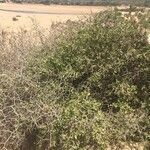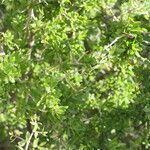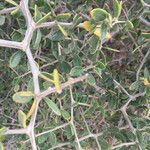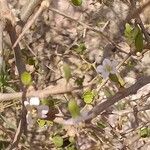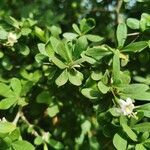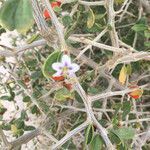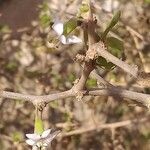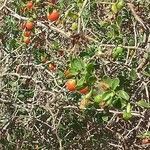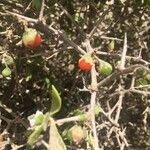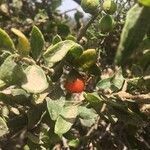Densely branched evergreen shrub, 1-6 m high. Shoots and young lvs with minute glandular scales. Lvs subsessile or shortly petiolate, alternate on young shoots but on mature stems mostly in fascicles on short spurs along the rigid branch spines. Lamina 5-43 × 3-12 mm, oblong, linear-oblong or spathulate; base attenuate; apex rounded-truncate. Fls 1-2-(3) together, on short spurs. Pedicels slender, c. 5 mm long at flowering, to 2 cm long at fruiting. Calyx 4-8 mm long, tubular-campanulate; teeth triangular, obtuse to acute. Corolla 10-13 mm long; tube broad-cylindric; lobes 4-5 mm long, obovate, pale mauve or cream; apex rounded. Filaments hairy at base. Fr. 5-12-(14) mm diam., globular or somewhat obovoid, scarlet.
An intricately branched shrub to 4 m with long, rigid branches; lateral branches leafy, ending in a stout spine. Leaves usually clustered, obovate to elliptic, to 40 mm long, slightly fleshy when fresh, green. Pedicels 5–16 mm long. Calyx more or less tubular, 4–7 mm long. Corolla 10–12 mm long, pale lilac or white towards limb, the lobes lilac in centre; limb strongly reflexed. Stamens 5, exserted for 2–4 mm. Pistil c. 10 mm long. Fruiting calyx split irregularly once or twice. Berry globose to broadly ovoid, 5–10 mm diam., dull orange-red, with 35–70 seeds. Seeds 2.5 mm long, 1.5 mm wide, dull yellow.
A densely branched shrub. It grows 3-4 m high. It is very spiny. The main branches are drooping. The branches spread out at wide angles. The branches usually end in a spine. The small branches carry small shoots with a cluster of leaves. The leaves are bright green and slightly fleshy. They are broad and oval and rounded at the tip but tapering at the base. They are 10-30 mm long and 4 mm wide. The flowers are pale lilac or white. They occur singly or in pairs on short shoots. The fruit is an orange-red berry. It hangs down.
Stiffly branched, thorny shrub to 3 m. Leaves in tufts on short shoots, succulent, bright green, obovate-elliptic, 12-35 x 4-10 mm. Flowers bisexual, bell-shaped, white and purple, tube 6-8 mm with petals 3-4 mm long, stamens inserted ± halfway up tube, well exserted. Berries 8-10 mm diam., red.
Shrub, up to 3 m high, with stout peg-thorns. Leaves elliptic to broadly obovate, 12-24 mm long, glabrous. Flowers bisexual; calyx tubular, ± as long as corolla tube; corolla 6-8 mm long; nectary red, inconspicuous. Flowering time Oct.-Jan. Fruit globose, large, red berry.
